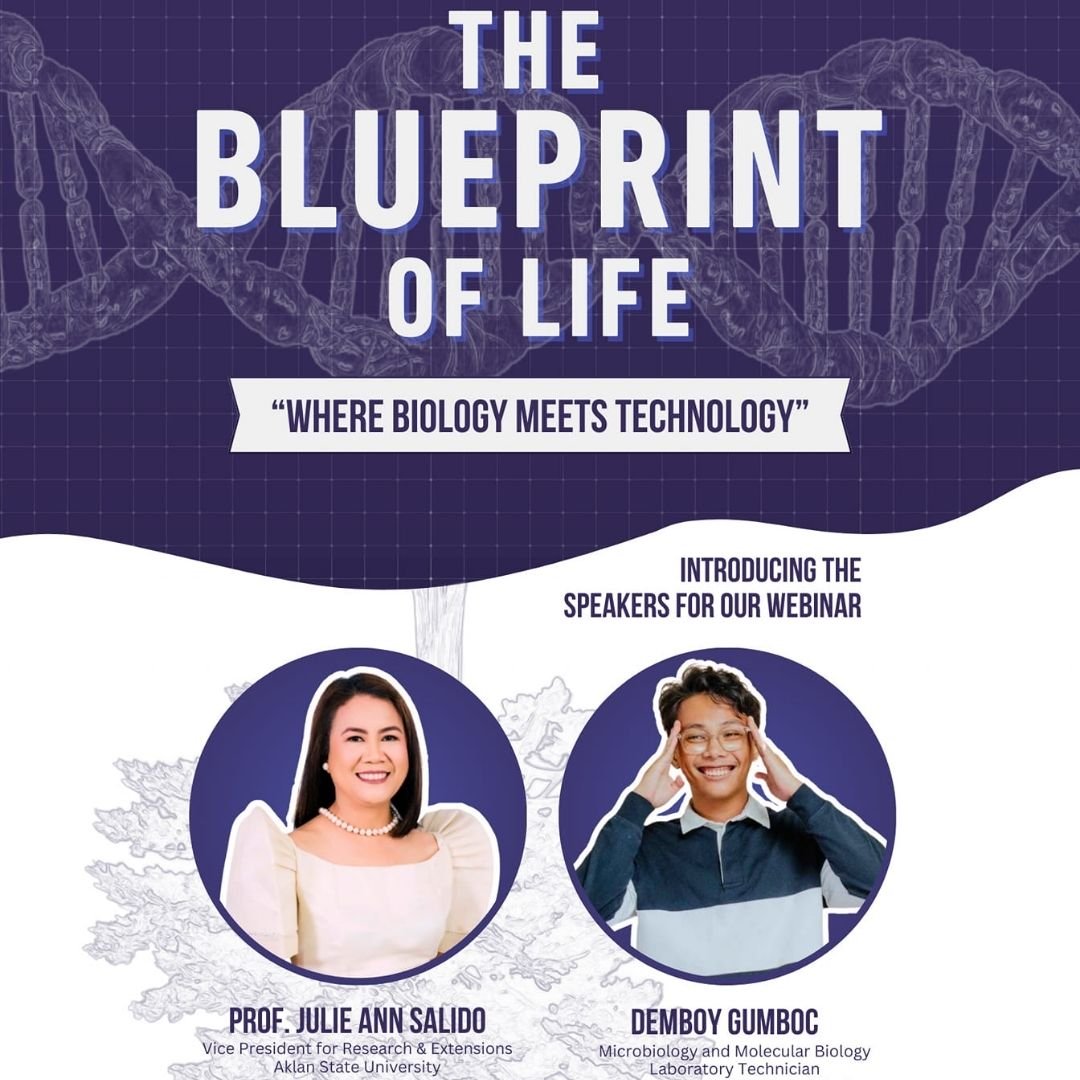On Saturday, November 16, 2024, I spent my morning from 9:00 AM to 12:00 PM attending a fascinating webinar titled “The Blueprint of Life: Where Biology Meets Technology” hosted on Microsoft Teams. Organized by Group 10 BSCS students from West Visayas State University (WVSU), this event opened my eyes to how biology and computer science can collaborate to address critical challenges in our world today.
The webinar featured two knowledgeable speakers who brought different perspectives to this interdisciplinary field. First, I listened to Mr. Demboy Gumboc, a Microbiology and Molecular Biology Laboratory Technician at WVSU-Main Campus. I appreciated how clearly he explained the similarities and differences between computer science and biology, helping me understand the nuances between bioinformatics and computational biology—fields that overlap yet serve distinct purposes. What I found particularly illuminating was his detailed explanation of the genome-wide association study (GWAS) of rice genes. As he walked through each step from quality control to final analysis, I gained insight into how computational tools enable scientists to unlock the mysteries of plant genetics.
The second speaker, Prof. Julie Ann Salido, Vice President of Research and Extensions at Aklan State University, captivated my attention with her focus on technology’s role in healthcare, specifically in detecting skin diseases. I was intrigued by her explanation of the Regional Convolutional Neural Network (RCNN) method that can identify skin conditions in images. The statistics she shared about increasing skin cancer cases in Asia made me realize the urgency of this work. Her description of the four phases of the cell cycle helped me connect these biological processes to their practical applications in medical technology. To keep us engaged throughout the session, the organizers included a fun game similar to “4 Pics 1 Word” with prizes for winners, which I found to be a refreshing break between the informative presentations. At the conclusion, I completed a feedback form that also served as my path to receiving an e-certificate.
Before attending this webinar, I primarily thought of computer science in terms of websites, apps, and software development. Now I understand that my field can also empower scientists to study genes and even improve food crops through research like GWAS. Mr. Gumboc demonstrated how computational techniques such as data analysis and algorithms serve as valuable tools for solving complex biological problems—a connection I hadn’t fully appreciated before.
I was struck by how meticulous and precise scientific research needs to be, especially when studying genetics. The GWAS process that Mr. Gumboc outlined involves numerous careful steps: quality control, identifying significant genetic markers, analyzing variations, and validating results. I realized that each step must be executed with precision, as errors could lead to incorrect conclusions. This reinforced for me that attention to detail is paramount when working with biological data, where small information handling mistakes can result in significant problems down the line.
Prof. Salido’s presentation on healthcare technology applications opened my eyes to how artificial intelligence can make tangible differences in people’s lives. I was amazed to discover that computer models can be trained to detect skin diseases early, potentially saving lives. The rising skin cancer statistics in Asian countries that she shared made the topic feel more relevant and pressing to me personally. I also gained valuable knowledge about the cell cycle’s four phases and how understanding these fundamental biological processes contributes to developing more effective medical technologies. Overall, the webinar expanded my perspective on how my computer science skills could extend far beyond creating games or apps—they could contribute to research, healthcare, agriculture, and potentially save lives.
As a computer science student inspired by this webinar, I’m excited to start applying what I learned in meaningful ways, even if I don’t yet have all the skills for advanced projects like GWAS or sophisticated medical imaging systems. I plan to begin exploring free bioinformatics tools like BLAST (Basic Local Alignment Search Tool) to understand how scientists compare DNA, RNA, or protein sequences. I also intend to practice with publicly available biological datasets to learn firsthand about data cleaning and analysis techniques used in actual scientific research.
Prof. Salido’s discussion about RCNN has sparked my interest in computer vision, and I’m now planning to learn about image recognition using libraries like TensorFlow or PyTorch by following their beginner-friendly tutorials. I believe that even simple projects, such as building a program that identifies different plants or animals in photos, will help me develop skills that could later apply to more critical work like disease detection. I’m also considering joining online communities where students and professionals share knowledge about bioinformatics and medical technology to continue my learning journey.
This webinar has influenced my thinking about future projects or thesis topics, and I’m now considering how I might combine computer science with biology or healthcare. Perhaps I could develop a simple app that helps people identify common skin conditions or create a program that analyzes plant health from images. Even as student projects, these would give me valuable experience working across different disciplines. I’ve come to realize that multidisciplinary thinking—looking beyond just my primary field—is an essential skill that the webinar emphasized. Being open to collaboration with experts from other domains can lead to more innovative and impactful solutions.
I found the webinar exceptionally well organized from start to finish. The schedule flowed smoothly with clear transitions between speakers and activities. Microsoft Teams proved to be an effective platform choice, offering good audio and video quality without significant technical issues. This made it easy for me to follow the presentations and remain engaged throughout the three-hour session.
Both speakers excelled at making complex topics accessible and interesting to me. They used approachable language when explaining technical concepts and provided real-world examples that helped me connect abstract ideas to practical applications. I particularly appreciated Mr. Gumboc’s step-by-step explanation of GWAS and Prof. Salido’s clear breakdown of how RCNN works for skin disease detection—both approaches were incredibly helpful for someone like me who is new to these fields.
The interactive “4 Pics 1 Word”-style game was a welcome addition that kept me energized and engaged. This activity provided a fun break between presentations and encouraged my active participation. I also appreciated how the organizers streamlined the post-webinar process by using Google Forms for both feedback collection and e-certificate distribution, saving me time and making it simple to complete all necessary steps to receive my certificate.
While I thoroughly enjoyed the webinar, I believe future events on these topics would benefit greatly from including live demonstrations of the tools and technologies discussed. I would have loved to see how a simple bioinformatics tool works in real-time or watch a basic computer vision model run on sample images, as this would have made the concepts more concrete and memorable for me. Even a brief 5-10 minute walkthrough of a basic application would help participants like me better understand how the technology functions in practice.
I also would have appreciated receiving a resource list at the end of the webinar. This could include links to beginner-friendly tutorials, free tools to explore, online courses, and relevant scientific papers or articles. Having these resources would support my continued learning after the webinar and provide clear next steps for exploring these fields further. A list categorized by skill level, from complete beginner to more advanced options, would be particularly helpful.
Additionally, extending the Q&A session would have allowed me more time to ask questions and engage directly with the speakers. While the current format did include time for questions, having a longer dedicated period for discussion would have given me more opportunities to clarify points or delve deeper into topics that particularly interested me. I also think creating a follow-up community, perhaps through a simple group chat or forum, would allow participants like me to continue discussions and share resources even after the webinar ends, helping build a small community of people interested in the fascinating intersection of biology and technology.

